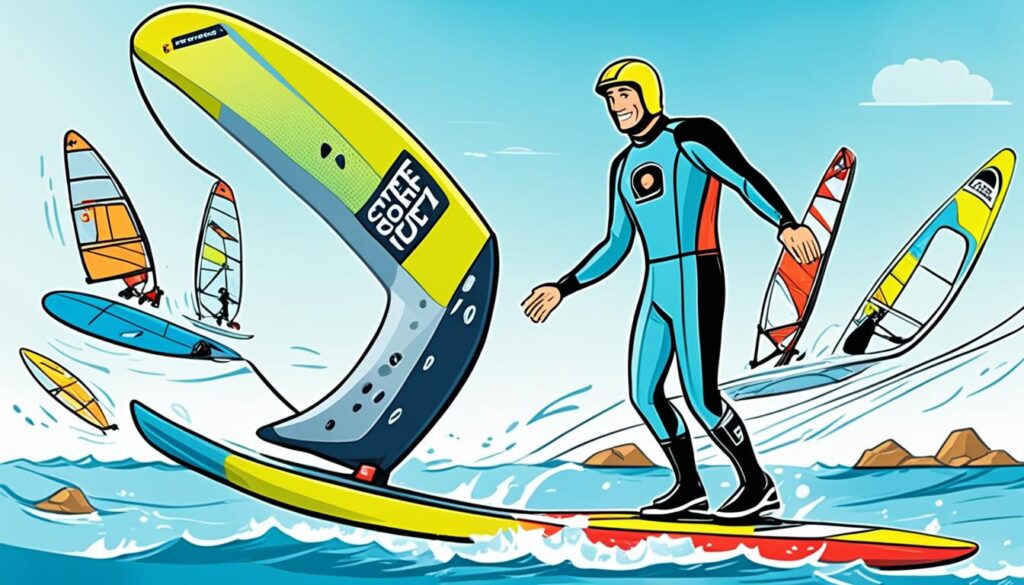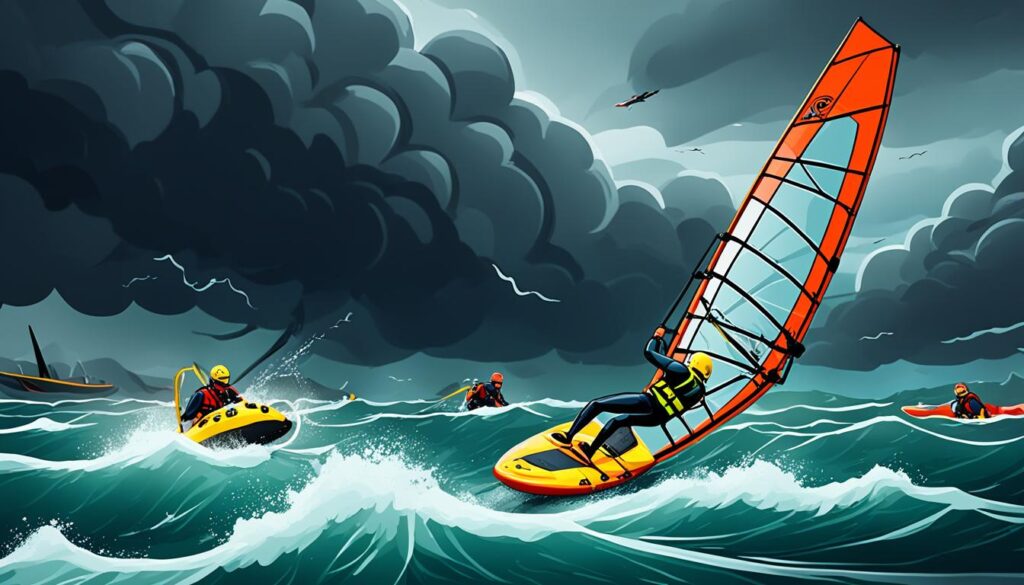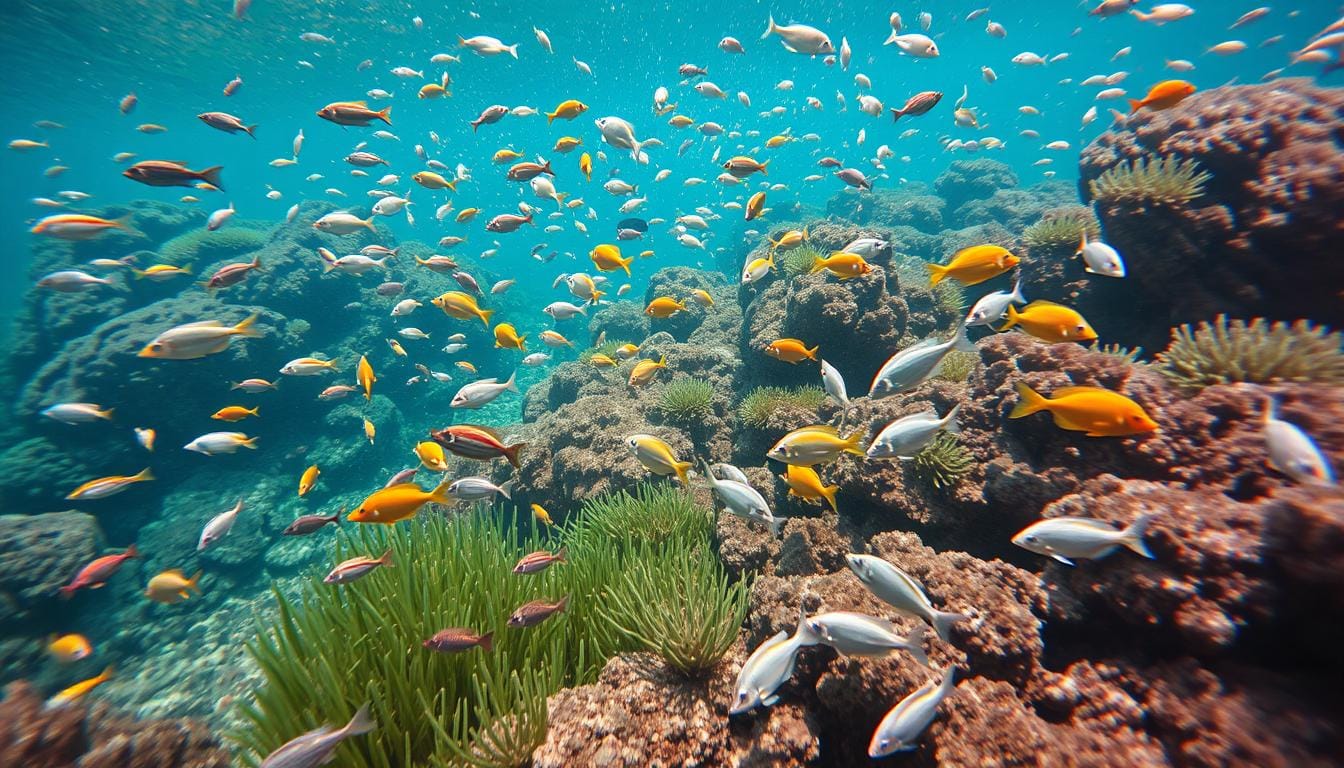Research shows about 10% of wind surfers will get seriously hurt at some point. This highlights the serious wind surfing dangers and why wind surfing precautions are crucial. Wind surfing is thrilling, but it’s also very risky. Surfers must treat it with great care and prepare well.
The excitement of the sport can hide its wind surfing risks. With strong winds and rough seas as its setting, wind surfing is far from calm. Even the most expert surfers can face wind surfing accidents. This is because a quick decision can turn an amazing experience into a frightening one.
Problems like collisions and equipment failures are common dangers in wind surfing. These issues show why keeping your gear in top shape is vital for wind surfing safety. Wind surfing is not only about being physically fit. It also requires a clear mind to avoid tiredness, which can lead to bad choices.
For those who love wind surfing, knowing how to stay safe is essential. You must find a way to have fun while also being cautious. This way, the excitement of wind surfing can be enjoyed safely for all.
Table of Contents
ToggleKey Takeaways
- Awareness of wind surfing dangers and risks helps in proactive accident prevention.
- Understanding the link between high winds, rough seas, and wind surfing hazards.
- The prevalence of wind surfing accidents underscores the need for strict safety measures.
- Regular equipment maintenance is as crucial as the proper execution of the sport itself.
- Effective wind surfing precautions include wearing protective gear and understanding one’s personal limits.
- Preparation and situational awareness are the bedrocks of mitigating wind surfing risks.
Understanding Wind Surfing Hazards
If you love wind surfing, knowing the risks is vital. Being aware of the dangers and preparing well makes the sport safer. It ensures you have fun without getting hurt.
The Risks Associated with High Winds and Rough Seas
Wind and waves are big challenges for wind surfers. Sometimes, you can lose control of your board. This is risky even for those who are very skilled.
Common Wind Surfing Injuries and How to Avoid Them
Wind surfing can cause injuries like sprains or cuts. But you can avoid most of these by being careful. Train hard, use good gear, and wear protective items.
Being fit and skilled also helps a lot. It keeps you safe and improves your performance in the water.
Navigating Obstacles: From Underwater Currents to Marine Life
Currents, rocks, and meeting marine life are dangers to watch out for. Knowing how to spot and react to these threats is key. It helps you sail around them without getting into trouble.
Being alert and ready for surprises is important. It’s how you can handle the sea’s unpredictable side.
Common Accidents in Wind Surfing and Prevention Strategies
Wind surfing is exciting, but knowing and managing its risks is vital for safety. This part looks at common wind surfing accidents and how to stop them.
Collisions with Other Surfers and Objects
Collisions are a major issue in wind surfing, especially in packed areas. In such places, not paying attention and being too close can cause accidents. To avoid this, keep a good distance from others and stay alert. Following these simple steps can keep you and others safe in the water.
Equipment Malfunction and Maintenance Tips
Taking care of your gear is vital for safe wind surfing. Broken equipment increases the risk of accidents. Surfers should check their boards, rigs, and sails often for any damage. This simple check can ensure your gear works well, reducing accident risks.
Impact of Fatigue and Overexertion on Surfer Safety
Feeling tired or pushing yourself too hard can be dangerous. It makes you surf poorly and takes away your decision-making skills. Remember to rest enough during your surfing to stay safe.
By knowing and following these safety tips, wind surfers can have fun safely. The sea can be tough, but with the right preparation and being careful, the risks can be low. Respect for the water and careful planning are key for every wind surfer’s safety.
Wind Surfing Dangers: Awareness and Preparedness
Increasing wind surfing awareness and preparedness lowers the risks of this thrilling sport. Knowing about weather and noticing changes in wind and sea is key. With proper training and knowledge, surfers can make dangerous situations less risky.
Being ready for wind surfing means getting fit and strong in your mind. Exercise and preparing for emergencies gets a surfer physically ready. Researching dangers helps mentally. With both these, surfers can take on challenges with confidence.
Being prepared is your best defence against the unpredictability of the ocean.
- Study weather forecasts meticulously.
- Understand the warning signs of changing wind and sea conditions.
- Equip yourself with the necessary safety gear.
- Never surf alone in risky conditions.
Understanding wind surfing dangers is crucial. Campaigns and education help spread important safety information. They make the sport safer for everyone and protect the environment too.
Essential Safety Gear for Wind Surfers
Surfing the wind safely means using gear that’s made for the job. From life jackets to advanced safety equipment, each piece is crucial for cutting down the risks in this sport.
Importance of a Properly Fitting Life Jacket
Every wind surfer needs a good life jacket. It keeps you afloat and stops you from drowning if you fall in. Make sure it fits well, though, so you can move freely.
Protective Clothing and Accessories to Mitigate Risks
Protection goes beyond life jackets in wind surfing. Wearing the right clothes and gear lowers your injury chances. Wetsuits, gloves, and water shoes all help keep you safe.
The Role of Helmets and Impact Vests in Impact Protection
Head and chest protection are critical. Helmets and vests make big falls or crashes safer. They’re key in avoiding bad injuries.

Following safety rules and picking the best gear is vital in wind surfing. It makes the sport more fun and keeps you safe, which matters a lot.
Evaluating Weather Conditions for Wind Surfing Safety
Understanding weather is key for wind surfing safety. Surfing safely means looking into the weather conditions closely. It’s not just about seeing if the sun will be shining. It means studying weather reports, watching clouds, and noticing wind shifts that could change things.
If you’re new to wind surfing, there are some things you must always remember. Here are some wind surfing precautions for you:
- Check many weather sources to get the best forecast.
- Watch for cloud shapes that might mean the weather will suddenly change.
- Look at the water to see if the wind is getting stronger or calmer.
Sometimes, a great day for wind surfing can become risky fast due to unexpected weather. This can raise the chance of accidents and injuries. So, checking the weather carefully beforehand is not just smart, but extremely important.
Watching the sky and keeping up with weather reports can make your wind surfing better and safer.
| Weather Conditions | Impact on Wind Surfing Safety |
|---|---|
| Stable, light winds | Great for beginners, a little risk of accidents |
| Shifting winds and storm clouds | Dangerous due to sudden gusts and low visibility, be very careful |
| Clear skies and steady winds | The best for all surfers, watch the conditions closely |
The more you know about how weather affects the sea, the safer and better your wind surfing will be.
Emergency Response: Handling Wind Surfing Accidents
When wind surfing, learning wind surfing accidents does happen but with emergency response training, we can cut these risks a lot. It’s crucial to know that injuries from wind surfing can get really bad very quickly. This is mainly because these accidents usually happen in far-off places.

The key to respond well to wind surfing injuries is knowing basic first aid. This means knowing how to treat sprains, cuts, and other usual water sport injuries. Also, knowing how to call for help using flares, flags, or tech means help can come fast.
- Always wind surf in pairs or groups: This not only makes it more fun, but it means you have help nearby if something goes wrong.
- Carry a waterproof communication device: Make sure it’s charged and working before you start surfing.
- Learn and practice rescue signals: Knowing these can really help if you’re in trouble and need help.
Following these steps cuts the danger of wind surfing injuries. It makes the whole experience safer and more fun for everyone.
The Psychological Impact of Wind Surfing Risks
Wind surfing’s risks affect both new and experienced surfers greatly. It’s not just physical – the mental challenges are huge too. Overcoming fears in wind surfing makes you perform better and feel good.
Managing Fear and Anxiety when Surfing in Extreme Conditions
The idea of wind surfing in rough conditions scares many. The worry of not being in control or getting hurt is real with big waves and strong winds. Facing these fears slowly helps. This makes you more confident and less scared. Together with mental prep, it keeps you safe.
The Importance of Mental Preparedness and Decision Making
Good decision making in wind surfing is key. Being ready in your mind helps you make fast, smart choices. This can stop accidents. Things like thinking ahead or imagining what could happen make your mind strong. You can then spot dangers early, keeping yourself safe.
| Strategy | Benefits | Impact on Psychological Well-being |
|---|---|---|
| Gradual exposure to difficult conditions | Builds confidence, reduces anxiety | Positive effects on stress levels and general mental health |
| Regular mental training | Enhances decision-making abilities | Increases focus, processing speed, and psychological resilience |
| Scenario planning | Improves readiness for unexpected events | Promotes a calm, controlled approach to critical situations |
The table shows important ways to cope in wind surfing. By using these methods, surfer’s fears lessen. This leads to better decisions and more joy on the water.
Conclusion
In the world of wind surfing, riding waves brings joy but also risks. Being aware, prepared, and protected is crucial. The talks in this guide highlight this, showing how important these ideas are. They let surfers enjoy their sport fully. With the right knowledge and gear, and a prepared mind, they can stay safe.
Prep for wind surfing is more than being fit and skilled. It’s about knowing weather, checking your gear, and emergency reactions. This solid preparation makes things safer. It lets lovers of the sport challenge themselves and get better. Together, an informed and ready community can explore wind surfing to the fullest, caring for each other’s safety.
Lastly, protecting wind surfers is a group effort. It relies on everyone choosing to be safe and to learn. This is as important as winning on the waves. By coming together around these values, wind surfers everywhere can enjoy their passion. They do so, always watching out for nature’s unexpected challenges.
FAQ
What are the main dangers associated with wind surfing?
Wind surfing comes with risks like sailing in strong winds and through rough seas. This can cause you to lose control or get hurt. You might also hit things or other surfers, or face dangers from the ocean’s hidden rocks and creatures.
How can I avoid common wind surfing injuries?
To stay safe and avoid getting hurt, it’s key to train well and use the right gear. Also, wear protective clothing and stay aware of your surroundings at all times.
What should I do to prepare for wind surfing in high winds and rough seas?
In tough conditions, start by checking the weather and sea forecasts. You should also be in good shape and have your skills ready for hard times. Make sure your gear is okay and you have all the safety stuff.
How can I prevent collisions while wind surfing?
To stop crashes, keep far from others and be alert. Try to steer clear of busy spots and talk to others so you understand each other’s moves.
Why is equipment maintenance so important for wind surfing?
Taking care of your gear stops it from failing and causing accidents. It also makes your gear last longer and work better.
How does fatigue affect my wind surfing safety?
Getting too tired makes you more likely to make mistakes. Be mindful of when you need a break. It’s better to rest than take a risk.
What essential safety gear should every wind surfer have?
Essential gear includes a life jacket, a wetsuit, and water shoes for your safety. Gloves and a helmet protect your hands and head. Impact vests safeguard your chest.
How do I evaluate weather conditions for wind surfing safety?
Before setting out, check the weather reports and look at the sky and water. This helps you understand if conditions are safe. Knowing your area’s weather patterns also helps.
What should my response be in the event of a wind surfing accident?
If an accident happens, keep calm and call for help if needed. Help an injured person if you can and try to get medical help as fast as you can. Surfing with others increases safety during accidents.
How can I manage fear and anxiety when wind surfing in extreme conditions?
Handling fear includes practicing in harder conditions, using calming methods, and staying mindful. Building your skills and knowledge can also boost your confidence.






Μία Απάντηση